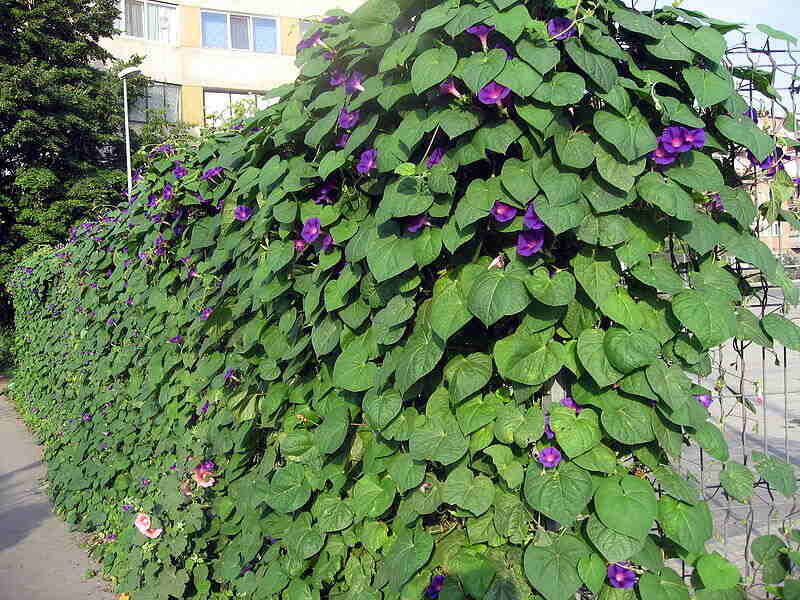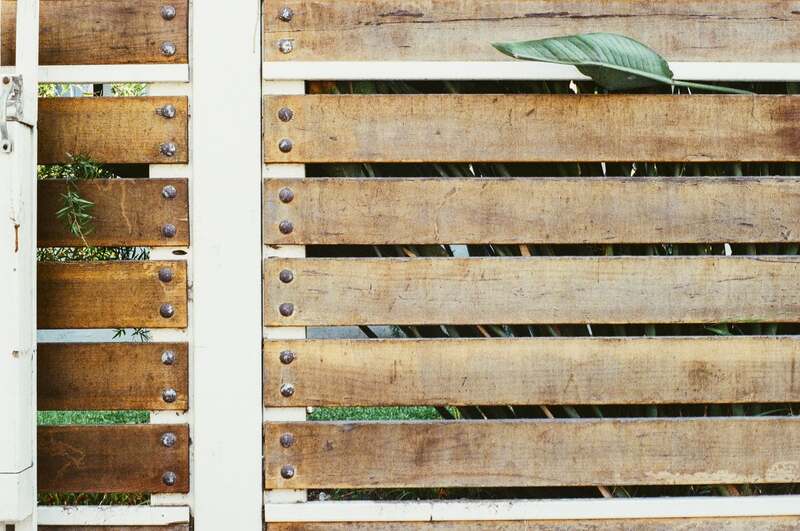
Chain-link fences may be affordable, but they don’t shield you from prying eyes. Sometimes you feel like a caged animal watched by every passerby. All you want is security and privacy. There are ways to make your existing chain-link fence private.
You can create privacy with your chain-link fence by doing a DIY project or with the help of a pro. There are several options to meet your budget and tastes, from purely practical to stylish.
Before you begin, look up the fencing restrictions in your area. You don’t want to end up having to pay a fine or having to start from scratch.
Slats
Insert slats vertically, horizontally, or diagonally between the intertwined metal wires in a chain-link fence. They are one of the most common privacy solutions, and many fence contractors offer PVC slats during installation. If you regret not getting them initially (or never had the chance), it’s not too late. Plus, now you won’t have limited color and material choices.
Pick between vinyl, aluminum, and wooden slats. Wood slats may look good, but they don’t have as long a lifespan as vinyl. If you still want the aesthetic appeal of wood, try faux-wood vinyl slats. Some even look like vinyl picket fencing with a horizontal slat holding the vertical slats in place.
Another benefit of chain-link fence slats is improved security. It’s more difficult to climb or cut through chain-link fencing with slats in the way.
Pros
✔ Comes in many colors
✔ Affordable
✔ Stays in place once installed
✔ Easy to replace broken pieces
✔ Improves security
Cons
✘ Not the most aesthetically pleasing option
✘ Requires more maintenance than regular chain-link
Cost: $3–$26 per linear foot of fence covered. Prices vary depending on the height of your fence.
Fence Tape
No, this tape isn’t sticky, but it may help you out of your sticky privacy situation. Like slats, you insert it through the gaps in the chain-link fence, but it’s made of flexible polyethylene material. Weave it through diagonally, fold it over, and attach it with brass fasteners.
Want to spice things up? Use multiple colors to create alternating stripes or partial strips to create patterns. You’ll need to plan your design carefully and cut them to size, but the results will be unique and eye-catching.
Pros
✔ Comes in many colors
✔ Lightweight
✔ Cheaper than vinyl slats
✔ Customizable
✔ Easy to replace broken pieces
Cons
✘ Time-consuming to install
✘ Can easily be cut through
Cost: 5 cents to 8 cents per foot of tape or $30-$40 per roll.
Plants
Want a living fence? A row of shrubs, trees, hedges, or ornamental grasses along your fence will add visual appeal without sacrificing the security of your existing chain-link fence. You can either plant them directly in the ground or put them in pots (a good option if your yard is hardscaped).

Make the “garden fence” by growing plants directly on the chain link. Vines such as ivy will climb up the fence to provide privacy (and a little extra height if they make it to the top). Flowers like wisteria and honeysuckle will add visual appeal and a sweet scent to your yard.
A vertical garden hanging off your fence also could obscure the view, though you will need many of them to create complete privacy. Hanging plants will make the best curtains to block an outsider’s view of your home and garden. Need more height? Put planters on top of your chain-link fence.
Note: Chain-link fences are durable and less likely to be damaged by climbing plants than other materials like wood or vinyl. However, they aren’t entirely immune. Keep an eye out for any shifting or displacement of your fence, as they could be signs you need to control your vines.
Pros
✔ Visually appealing
✔ Very customizable
Cons
✘ Plants need care
✘ Plants could get out of control
✘ Plants take time to establish
✘ Might not create complete privacy, depending on the plants and methods used
✘ Challenging to maintain or fix the fence itself if the plants grow directly on it
Cost: $1-$90 per plant. Seeds are the cheapest option, but they’ll take more time to provide privacy than grown plants.
Artificial Hedges
Hate watering and pruning? Not everyone is the gardening type, but that doesn’t mean you must sacrifice the greenery. Artificial hedges stay green year-round and come in various styles. Choose anything from faux evergreen to ivy. You can either buy slats to insert between the chain links or roll out a sheet to cover everything at once. They also come in square panels that attach and detach from each other, so you can customize the height and length to match your fence.
Browse your options and read reviews carefully. You want to ensure your purchase will last for years and stand up to your local weather conditions.
Pros
✔ Adds visual appeal
✔ Easy installation
✔ Doesn’t require maintenance like real plants
✔ Relatively inexpensive
Cons
✘ It might look too fake for your tastes
✘ It could deteriorate over time, and it can’t grow back like real plants
Cost: $9-$30 per linear foot for artificial hedge slats. $1-$15 per linear foot for roll-out artificial hedge screens. $4-$6 per square foot for a hedge panel.
Privacy Mesh

Privacy mesh or privacy screens are made of polyethylene fabric. They come in various colors and patterns, so you can find one to suit your tastes. Privacy mesh often doubles as windscreens, making it an excellent option for yards that need shelter from the elements.
To install privacy mesh, put zip ties or bindings through the grommets or poke holes as necessary. Install it on the side without posts, and make sure the fabric is tense between each zip tie to prevent wrinkles.
Pros
✔ Affordable
✔ Easy installation
✔ Comes in many colors and styles
✔ Provides complete privacy
✔ Protects from wind
Cons
✘ Could have ripples or other visual detractors if installed incorrectly
✘ Not as visually appealing as other solutions
✘ Material could tear
Cost: 75 cents–$2 per linear foot
Lattice
Do you regret not getting a lattice fence? Good news: You can make your chain-link fence look more like one. Buy wooden or vinyl lattice panels in your preferred color and thickness.
Attach the panels to the inside of your existing fence with zip ties. Want them to be more secure? Add horizontal fence boards along the top and bottom of the fence to keep everything in place. Attach the panels above the ground to preserve their lifespan; soil moisture and pests like termites and carpenter ants could deteriorate the wooden lattice.
While lattice will obscure the view into your yard better than regular chain-link fencing, this is not a complete privacy solution.
Pros
✔ Visually appealing
✔ Can easily be added and removed
Cons
✘ Only provides partial privacy
✘ Wooden lattice is susceptible to water and wood-destroying pest damage
✘ Requires more maintenance
Cost: $7–$11 for vinyl lattice. $4–$45 for wooden lattice.
Wooden Fence Panels

Want more privacy than lattice provides? Wooden fence panels provide a wooden fence’s visual appeal and privacy without sacrificing your existing chain-link fence. You can buy pre-assembled fence panels or create custom ones with fence pickets and vertical posts.
Choose from various types of wood and customize with stains and paints. You also can orient them vertically or horizontally. Install wooden panels over your chain-link fence using c-brackets or u-bolts and zip ties. You will need to access the back side of your fence to install panels.
This method is best for homeowners who already have a chain-link fence and don’t want to remove it. If you’re installing a new fence, consider a wooden privacy fence instead.
Pros
✔ Comes in a variety of styles
✔ Adds visual appeal
✔ If attached to an existing chain link fence, it’s less work to install than a new wooden privacy fence
Cons
✘ Wood requires more maintenance than chain link
✘ Could come off if it’s not adequately secured
✘ Vulnerable to the elements and wood-destroying pests
✘ Not worth it if you’re installing a new chain-link fence; install a wooden privacy fence instead to save money.
Cost: $7–$22 per linear foot for assembled fence panels. 99 cents– $22 per wooden picket if you want to assemble your own panels.
Bamboo Fence Screen

Is wood not your cup of tea? Maybe bamboo suits you better. Bamboo fence screens are affordable and come in various natural colors, styles, and thicknesses. They come in panels and rolls. Install them vertically or horizontally and secure them with zip ties or wires. Buy taller panels to add height to your fence.
Pros
✔ Visually appealing
✔ Gives a more natural look
✔ Easy to install
Cons
✘ Can be fragile
✘ Only provide partial privacy
✘ Can be expensive
✘ Vulnerable to humidity, moisture, and pests
Cost: $6–$43 per linear foot or $40–$340 per roll
Reed Fence Screen
Want a more affordable alternative to bamboo? Reed fence screens look similar to bamboo but tend to be cheaper, thinner, and a bit more delicate. They also come in woven styles for a more interesting visual appeal. Roll them across the interior of your fence and secure them with zip ties.
Pros
✔ More affordable than bamboo screens
✔ Lightweight
✔ Easy to install
✔ Aesthetically appealing
Cons
✘ Usually delicate
✘ Short lifespan
✘ Only provides partial privacy
Cost: $2–$10 per linear foot or $17–$310 per roll
Fence Decorations
Want to get a little more creative? Try decorating your fence if you’re itching for a new DIY project. With what, you may ask? Anything you want! You can use anything you can fasten to the fence, put between the chain links, or lean against the fence.

Here are some fence decoration examples:
- Street signs
- Surfboards
- Skateboards
- Skiis
- CDs
- Old doors
- Tiles
- Stained glass
- Tarps
- Flags
- Blanket
- Cloth (either draped, woven through, or stuffed through openings)
While these ideas may be quirky and fun, many of them will take time and patience to put together. They also may not be wholly private or durable. Choose materials that can handle your local weather. And make sure your neighborhood allows for such creative fun.
Pros
✔ Unlimited creativity
✔ Can use recycled materials
Cons
✘ Time-consuming
✘ May be challenging to find specific materials
✘ Materials could be expensive
✘ Might not offer complete privacy
✘ Might not be as durable as privacy products designed for chain link fences
Cost: 22 cents–$100 per decoration
FAQ About How to Make a Chain-Link Fence Private
How Do I Add Privacy and Height to my Chain Link Fence?
Before making your fence taller, check local or HOA regulations for maximum fence height. If you’ve got wiggle room, here are some solutions:
- Post extenders: Attach metal or PVC post extenders to the top of your existing fence posts. From there, you can put more chain-link fabric, chicken wire, welded wire, or mesh between them. Secure the new material to the poles and the chain-link fabric below.
- Install a taller screen or panel: If you’re already going to add a privacy screen or panel along your fence, just choose one taller than your fence.
- Add plants: If you’re interested in greenery, this is a two-in-one solution. Plant tall trees, shrubs, or hedges along the fence. Vines will add a little height as well. If you want something more controllable, place planters along the top of the fence. Search for ridge rail or hanging planters for chain-link fences.
How Do You Discreetly Dog Proof a Chain-Link Fence?
That depends on whether your dog is a digger or a jumper.
If your dog loves digging, push stakes into the ground along the fence’s edge. They need to be close enough so your dog can’t squeeze through. Camping stakes are great for this project because you can push them far enough into the ground so they won’t be visible from afar. Hook them onto the bottom chain links to keep them secure.
You can also lay down a footer. A footer creates an L-shaped wire barrier at the bottom of the fence. This wire is difficult or uncomfortable for your dog to dig through. If you don’t like how the footer looks, cover it with decorative mulch.
What if your dog’s a jumper? If a taller fence isn’t helping, maybe rollers will. As the name implies, these cylindrical devices roll so pets can’t get a grip. You can make them using PVC pipes, or buy metal ones to match the fence. You also can install a fence topper that curves inward, blocking your dog’s path. However, these may not be as discreet as you’d like.
If your dog escapes through a hole in the chain link, consider adding slats, panels, or other barriers. These will make it less likely for the chain link to be warped or pushed through by a persistent pooch.
How Do You Stop Thieves From Getting Through a Chain Link Fence?
While making a fence 100% secure is difficult, here are some additions that could make your chain-link fence more secure.
- More height: Easy-to-hop fences make homes a welcome target. Make it more difficult for them by increasing the height of your chain-link fence. While it won’t stop everyone, it might be just enough to deter some criminals.
- Thicker and more durable material: If a thief isn’t climbing your fence, they’re probably cutting through it. Replace your old chain link fabric with thicker wire and more durable materials that are harder to cut. The lower the gauge is, the thicker the wire. Steel is stronger than aluminum.
- Barbed wire: This spiky surprise is challenging for thieves to pass over. While barbed wire may seem like an obvious choice, some areas ban or restrict it. Municipal regulations may require your fence to be taller or the barbed wire to face away from public walkways. These regulations are to prevent accidental injury. Check local rules before installing barbed wire, razor wire, electric fences, or sharp points.
- Privacy barriers: If thieves can easily see your yard and home, they can better see your valuables and create a plan to take them. Privacy barriers make it more difficult for them to window shop, so to speak. They also can make fences more challenging to climb or cut through.
- Fence detection systems or perimeter alarms: These are often used by governmental agencies and businesses but are also available for homeowners. Fence detection systems feel the vibrations caused by cutting or climbing.
If nothing works, you might need to replace your fence with a more secure design. Steel, iron, concrete, and wooden fences are more difficult to climb than chain-link fences. Look for designs and materials that can’t be cut through and don’t have footholds.
When to Hire a Fencing Pro
These privacy solutions for chain-link fences may save you money, but they’re not the same as a privacy fence.
Maybe it’s time for a new fence altogether. While you could build it yourself, you also could hire a pro to save yourself the trouble. Connect with a fencing professional who can be sure the job is done right.
Main Image Credit: Sameer-123 / Wikimedia Commons / CC BY-SA 3.0